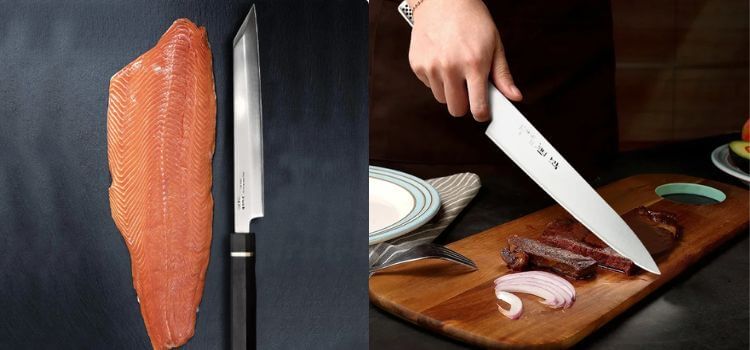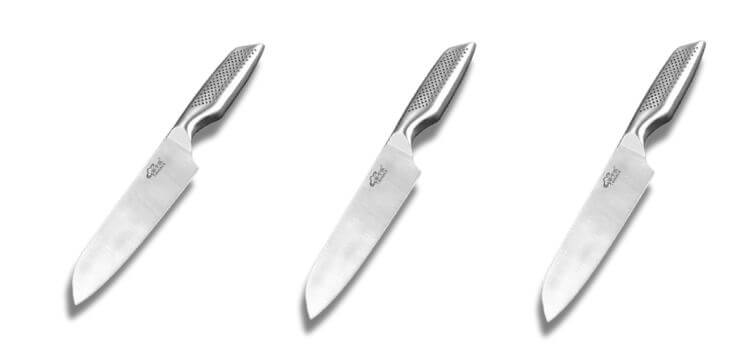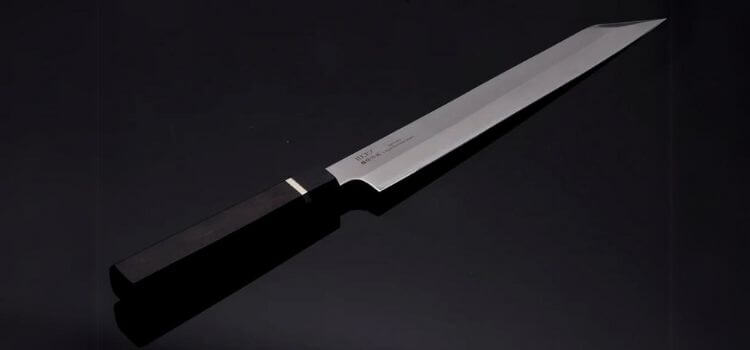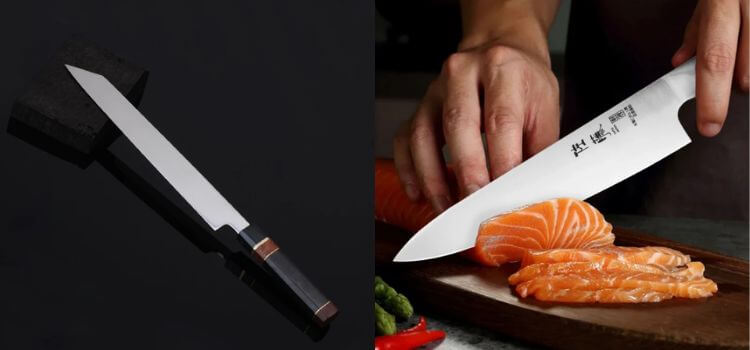As an Amazon Associate, I earn from qualifying purchases

When equipping your kitchen with the right tools, the Kiritsuke and the Chef Knife debate often takes center stage. Both revered for their versatility and precision, these knives cater to different culinary needs and styles.
This piece delves into the characteristics, uses, and principal distinctions between the Kiritsuke knife and the traditional Chef’s Knife. We aim to give you the insights to choose the blade that perfectly complements your culinary adventures.
Origins and Design
Chef Knife

Origin and history:
While the origins of the Chef Knife are debated, it is believed to have originated in France during the 19th century. A French cutlery company designed it as an all-purpose kitchen knife for chefs, thus earning its name.
Blade design and characteristics:
The Chef Knife has a slightly curved blade with a pointed tip, similar to the Gyuto. Nevertheless, it presents a shorter and broader profile than the Gyuto, featuring a more robust spine and a distinctly enhanced curve near the tip. This design makes it ideal for rocking motions while cutting and chopping.
Handle styles and ergonomics:
Chef knives usually feature handles in a Western style, designed using materials like wood, plastic, or metal; these creations enhance both functionality and aesthetic appeal. The handles are usually larger and heavier than WA handles, providing a better grip and balance for heavy-duty tasks.
Kiritsuke Knife

Origin and history:
The Kiritsuke Knife has a rich history dating back to Japan’s feudal era when they were used by samurai warriors for self-defense. The knife evolved, with artisans perfecting its design and sharpening techniques.
Blade design and characteristics:
A Kiritsuke knife looks like a cross between a Usuba and Yanagiba knife and is designed for precision cutting, slicing, and julienning. It features a flat blade with a pointed tip and a sharp angled edge on one side. This design allows the knife for both push and pull cuts.
Handle styles and ergonomics:
Kiritsuke knives usually feature handles in a Japanese Wa style, crafted using traditional materials like wood, horn, or buffalo bone. The handles are lighter and thinner than Western-style handles, providing greater control and precision for delicate tasks.
Functionality and Versatility
Chef Knife
The Chef Knife’s design optimizes it for managing more demanding tasks in the kitchen, blending functionality with precision. Its wider blade and curved edge allow for rocking motions while cutting, making it perfect for chopping, mincing, and dicing.
Primary uses in the kitchen
- Chopping, mincing, and dicing vegetables, fruits, and meats
- Breaking down more significant cuts of meat or bones
- Slicing through tough ingredients like squash or root vegetables
Ideal scenarios for use
- Preparing large meals with heavy-duty cutting tasks
- Handling tougher ingredients that require more force to cut
Pros and Cons of Chef Knife
Pros:
- Strong and durable, suitable for heavy-duty tasks
- Ideal for handling tough or thick-skinned ingredients
- Good for beginners due to its simple design and ease of use
Cons:
- It may not be as precise for intricate tasks like peeling or carving
- It is not as versatile as the Gyuto Knife for different cutting techniques.
Kiritsuke Knife
The Kiritsuke Knife’s design optimizes it for precise cutting, slicing, and julienning. Its flat blade and sharp angled edge make it perfect for straight cuts and delicate tasks.
Primary uses in the kitchen
- Slicing sashimi or other raw fish with precision
- Cutting thin slices of vegetables like cucumbers or carrots
- Perfecting decorative cuts or presentations
Ideal scenarios for use
- Preparing delicate dishes with a focus on presentation and precision
- Slicing through soft ingredients without crushing or tearing them
Pros and Cons of Kiritsuke Knife
Pros:
- Precise and versatile, suitable for various cutting techniques
- Excellent for intricate tasks like peeling or carving
- Perfect for creating decorative cuts or presentations
Cons:
- Not as durable as the Chef Knife, it may not be suitable for heavy-duty tasks
- Its single bevel edge requires more maintenance and sharpening techniques.
Key Differences between Kiritsuke and Chef Knife

- Blade Design: The Kiritsuke Knife features a flat blade that culminates in a sharply angled edge, contrasting with the Chef Knife’s curved blade that tapers to a pointed tip. This design difference affects the cutting techniques and tasks each knife is best suited for.
- Handle Styles: The Kiritsuke Knife typically features a lighter and thinner Japanese Wa handle, while the Chef Knife has a heavier and larger Western-style handle. This distinction impacts the balance, grip, and ergonomics of each knife.
- Cutting Techniques: The Kiritsuke and Chef Knife are best suited for different cutting techniques due to their different blade designs. The Kiritsuke excels at precise and intricate tasks like peeling or carving, while the Chef Knife is better for heavy-duty tasks like chopping or breaking down larger cuts of meat.
- Durability: The Chef Knife is generally more durable than the Kiritsuke Knife due to its thicker spine and sturdier design. However, With appropriate maintenance and care, both knives can endure for many years.
Conclusion
In conclusion, the Kiritsuke and Chef Knife are essential tools in any kitchen. The Chef Knife is best suited for heavy-duty tasks and offers versatility in handling various ingredients, while the Kiritsuke excels at precise and intricate cutting techniques.
Ultimately, selecting between these two knives boils down to individual preferences and the unique requirements of each chef or home cook. So, it is important to understand the differences and strengths of each knife to make an informed decision.
As an Amazon Associate, I earn from qualifying purchases
Pingback: Electric Fillet Knife vs Regular